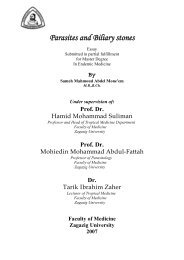E. Coli
E. Coli
E. Coli
Create successful ePaper yourself
Turn your PDF publications into a flip-book with our unique Google optimized e-Paper software.
Review of Literature<br />
Mohamad (1996) examined 150 baby chicks; disease and freshly<br />
dead at Sharkia Governorate broiler farms. He found the incidence of<br />
Klebsiella species (33.3%), Proteus species (22%) and Psendomonas<br />
aeroginosa (8.7%).<br />
Barnes and Gross (1997) reported that Proteus morgani has<br />
been associated with respiratory disease in chickens.<br />
Sakr (1998) found that 15 Salmonella species (2.4%), 14<br />
Klebsiella species (2.4%), 12 Proteus species (2.1%), 9 Shigella<br />
species (1.5%), 7 Citrobacter species (1.2%) and 8 Pseudomonas<br />
aeruginosa (1.3%). Serological identification of the isolated forty E.<br />
coli strains revealed 9 O:128 (20%), 7 O:1 (15.6%), 3 O:14 (13.3%)<br />
5 O:26 (11.1%), 4 O:1 (8.9%), 4 O:125 (8.9%) and 3 O:3 with<br />
prevalence of 6.7%.<br />
Hatab (2001) reported that mash ration of broilers proved to be<br />
highly contaminated with many pathogenic and potentially pathogenic<br />
organisms of Enterobacterialecie than pelleted feed Klebsiella species<br />
were isolated (32%) from raw mash, P. margani (M. morganii) (16%).<br />
Proteus mirabilis (8%), Salmonella species (12%), Enterobacterial<br />
species (16%) and Citrobacter species (8%), while in pellet feed<br />
Klebsiella species (24%), Proteus mirabilis (4%) and Citrobacter<br />
species (4%).<br />
Taha (2002) isolated Proteus species (13%), Klebsiella (4.3%),<br />
Citrobacter species (21.7%), Entrobacter species (4.3%) and<br />
Edwardsiella species (13%) from chicken in Sharkia. Enteric bacteria<br />
were isolated from water samples as Proteus (11.5%), Klebsiella<br />
17
















